Country Capital Population 4.477 million (2011) | Area 147,307 km2 Governor Christiandy Sanjaya | |
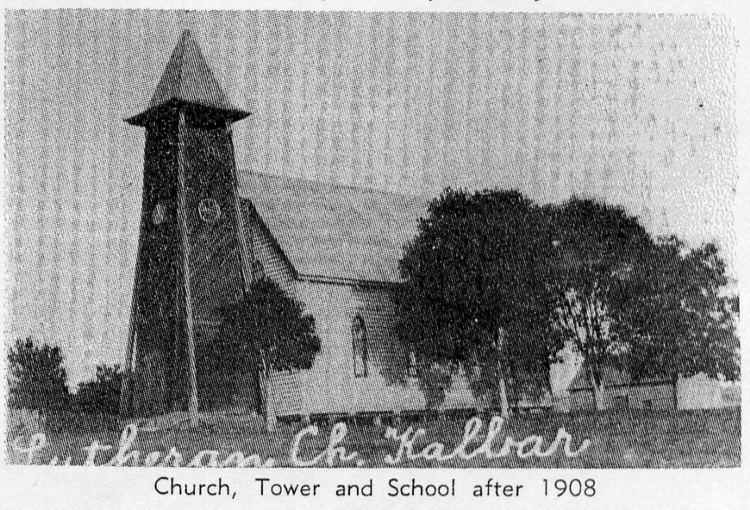 | ||
University Tanjungpura University Languages spoken | ||
Map of West Kalimantan
West Kalimantan (Indonesian: Kalimantan Barat, Chinese: 西加里曼丹; Teochew: Sai-gia-li-man-dang) is a province of Indonesia. It is one of five Indonesian provinces in Kalimantan, the Indonesian part of the island of Borneo. Its capital city is Pontianak. The province has an area of 147,307 km² with a recorded 2010 census population of 4,395,983 . Ethnic groups include the Dayak, Malay, Chinese, Javanese, Bugis, and Madurese. The latest official estimate (as at January 2014) is 4,546,439. The borders of West Kalimantan roughly trace the mountain ranges surrounding the watershed of the Kapuas River, which drains most of the province. The province shares land borders with Central Kalimantan to the southeast, East Kalimantan to the east, and the Malaysian territory of Sarawak to the north.
Contents
- Map of West Kalimantan
- West kalimantan
- History
- Boundary
- Topology
- Lakes and Rivers
- Administrative divisions
- Proposed new province of Kapuas Raya
- Ecology
- Ethnic Group
- Language
- Religion
- Traditional Dance
- Traditional Clothes
- Traditional Weapon
- Traditional Houses
- Festivals
- References
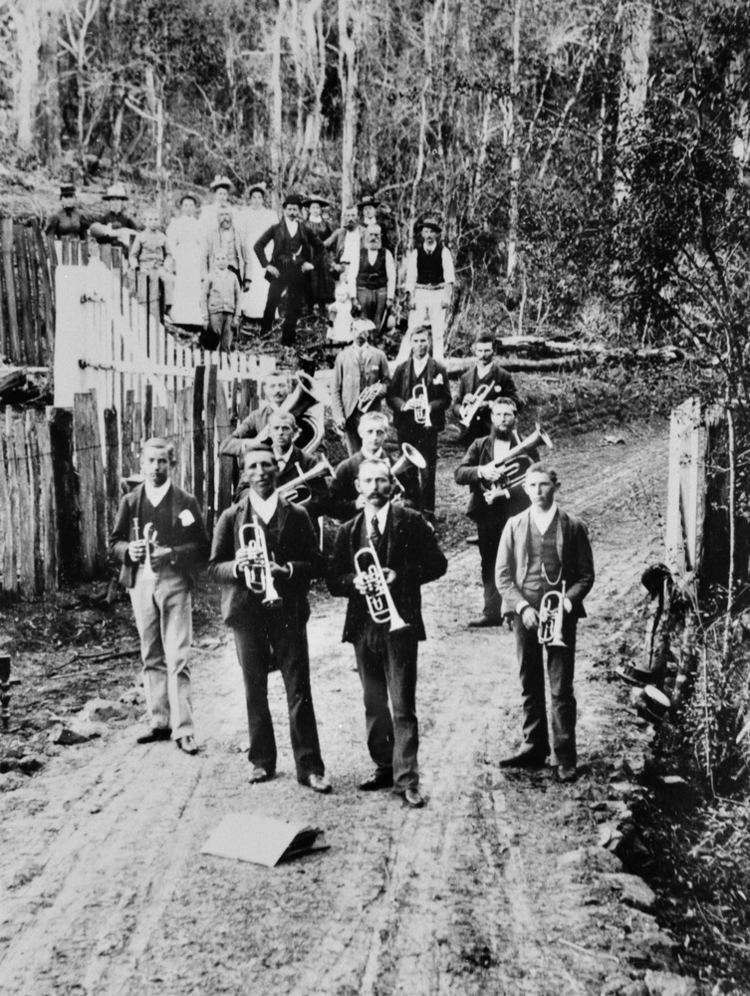
West Kalimantan is an area that could be dubbed "The Province of a Thousand Rivers". The nickname is aligned with the geographical conditions that have hundreds of large and small rivers that which can be and often are navigable. Several major rivers is still a pulse and the main line for freight hinterland, despite road infrastructure has been able to reach most districts.

Although a small part of West Kalimantan region is sea water, West Kalimantan has dozens of large and small islands (mostly uninhabited) spread along the Karimata Strait and Natuna Sea that borders the province of Riau Islands. The total population in the province, according to the 2000 census totaled 4.07343 million inhabitants (1.85% of Indonesia's population).
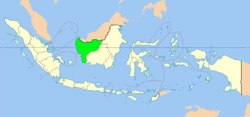
West kalimantan
History
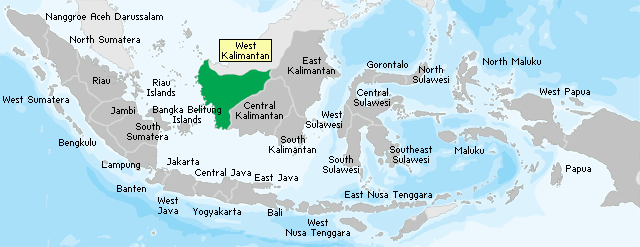
The history of West Kalimantan can be traced back to 17th century. Dayaks were the main inhabitants of the province before the 17th century. The Malays migrated to West Kalimantan and established their own sultanates. The high Chinese population in this province was due to a republic founded by Chinese miners called Lanfang Republic (蘭芳共和國: Republik Lanfang) after they defeated the local Malay sultans. The government of Lanfang Republic was ended in West Kalimantan after the Dutch occupation in 1884.
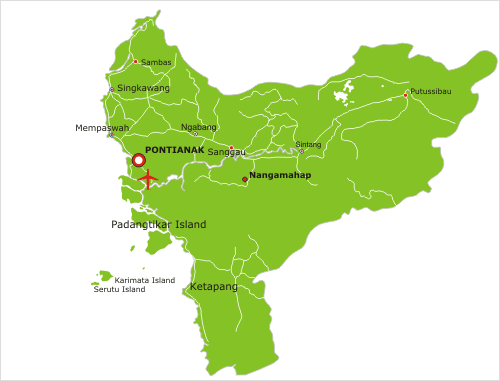
West Kalimantan was under Japanese occupation from 1942 to 1945, when Indonesia declared its Independence. During the Japanese occupation, more than 21,000 people in Pontianak (including sultans, men, women and children) were kidnapped, tortured and massacred by Japanese troops during the Pontianak incidents. All the Malay Sultans on Kalimantan were executed and the Malay elite was devastated by the Japanese.
The massacre occurred from April 23, 1943 to June 28, 1944 and most of the victims were buried in several giant wells in Mandor (88 km from Pontianak). Allied forces occupying the area after the war found several thousand bones, and more than 60 years after the massacre, several secret graves of the victims were found in Mandor and the surrounding areas.
After the end of war, the Japanese officers in Pontianak were arrested by allied troops and brought in front of an international military tribune. During the trial, it was revealed that the plan to start the rebellion did not exist and instead was only an imaginary plan created by Japanese officers who wanted to get promoted.
A monument called Makam Juang Mandor was created to commemorate this tragic event.
West Kalimantan was the site of substantial fighting during the Indonesia-Malaysia confrontation under the Sukarno government in the mid-1960s. After Suharto deposed Sukarno in 1965, the confrontation was quickly resolved. Domestic conflict continued, however, for another ten years between the new military Suharto government and fighters organized during the confrontation and backed by the banned Indonesian Communist Party (PKI).(see Indonesian killings of 1965–66)
During the 1930s the Dutch colonial powers initiated a "transmigration plan" to move people from heavily populated islands such as Java, to the less populated islands of Irian Jaya and Kalimantan. In the 1960s the Indonesian government granted the Madurese rights to clear forests for palm oil cultivation. This conflicted with the local Dayak tribes' traditional way of life. The tensions between the two ethnic groups resulted in major eruptions of violence in 1996, the Sambas riots in 1999 and the Sampit conflict in 2001, resulting in thousands of deaths.
Boundary
West Kalimantan Province is located in the western part of the island of Borneo, or in between the lines 2°08'N and 3°05'S and between 108°0'E and 114°10'E. The province is traversed by the Equator (latitude 0°), precisely through the city of Pontianak. West Kalimantan has a tropical climate, with often high temperatures accompanied by high humidity.
Other specific characteristics is that the West Kalimantan region including one of the provinces in Indonesia which is directly adjacent to another country on land, namely the State of Sarawak, East Malaysia. Even with this position, West Kalimantan is currently the only province in Indonesia that have officially had access road to get in and out of a neighboring country. West Kalimantan and Sarawak have open roads approximately 400 km long, spanning Pontianak-Entikong-Kuching (Sarawak, Malaysia) and can be reached about six to eight hours of travel. In the northern part of the province, there are four regencies that directly borders Malaysia, namely Sambas, Sanggau, Sintang and Kapuas Hulu, which stretch along the Kalingkang Mountains-Kapuas Hulu.
Most areas of West Kalimantan is a low-lying land with an area of 146 807 km2, or 7.53 percent of the total Indonesian or 1.13 times the size of the island of Java. This region stretches straight from north to south along more than 600 km and about 850 km from West to East. Judging from the size of the territory, West Kalimantan is Indonesia's third largest province by area, after Papua (421,891 km2) and Central Kalimantan (152 600 km2). The largest regency is Ketapang (35,809 km2 or 24.39 percent) followed by Kapuas Hulu (29 842 km2 or peresen 20:33), and Sintang (21 635 km or 14.74 percent), while the rest spread over 9 (nine) regencies.
Topology
In general, West Kalimantan land is low-lying and has hundreds of rivers are safe when navigable, slightly hilly which extend from west to east along the valley Kapuas and Natuna Sea / Strait Karimata. Most of the land area is swampy mix of peat and mangrove forests. The land area is flanked by two mountain ranges, namely, Kalingkang Mountains in the North and the Schwaner Mountains in the south along the border with the province of Central Kalimantan. Judging from the soil texture, the majority of West Kalimantan area consists of the soil type PMK (podsolet red-yellow), which covers an area of about 10.5 million hectares, or 17.28 percent of the total area of 14.7 million hectares. Next, the ground OGH (orgosol, gley and humus) and the alluvial soil of about 2.0 million hectares, or 10.29 percent sprawled across Dati II, but most likely in the coastal district.
Influenced by the vast lowlands, the heights of the mountains are relatively low as well as non-active. The highest mountain is Mount Baturaya in District Serawai, Sintang which has an altitude of 2,278 meters above sea level, far lower than Mount Semeru (East Java, 3,676 meters) or Mount Kerinci (Jambi, 3,805 meters).
Mount Lawit located in Kapuas Hulu, district. Embaloh Hulu and more formerly known in West Kalimantan, only occupies the third highest because it has a high 1,767 meters, while the second highest is Mount Batusambung (Subdistrict Ambalau) with a height of up to 1,770 meters.
Lakes and Rivers
West Kalimantan is an area that could be called "The Thousand Rivers Province". The nickname is in line with the geographical conditions that have hundreds of large and small rivers, among others, can be and often are navigable. Several major rivers is still the lifeblood and main line to transport the countryside, although the road infrastructure has been able to reach most districts.
The main large rivers are the Kapuas River, which is also the longest river in Indonesia (1,086 km), which along 942 km are navigable. The great rivers are: Melawi, (navigable 471 km), Pawan (197 km), Kendawangan (128 km), Jelai (135 km), Sekadau (117 km), Sambas (233 km ), and Landak (178 km).
Although rivers have very prominent numbers in West Kalimantan, there are only two significant lakes in the province. Both lakes are Lake Sentarum and Lake Luar I that are in Kapuas Hulu. Lake Sentarum, has an area of 117,500 hectares, which sometimes is almost dry in the dry season, and Lake Luar I, which has an area of approximately 5,400 hectares. Both of these lakes have potential as a tourist attraction.
Administrative divisions
West Kalimantan is subdivided into two cities (kota) and twelve regencies (kabupaten). About 29 percent of the province's population lives in the Pontianak area. The capitals and populations of the regencies and cities are:
Notes:
Proposed new province of Kapuas Raya
On 25 October 2013, the Indonesian House of Representatives (DPR) began reviewing draft laws on the establishment of 57 prospective regencies and 8 new provinces; one of the proposed provinces is Kapuas Raya in West Kalimantan. If the bill is approved, this will make Kapuas Raya the fourth largest province in Indonesia after Papua, East Kalimantan and Central Kalimantan, as the total area of Kapuas Raya, encompassing five regencies, will measure 80,432 square km, or 54.79 percent of the current size of West Kalimantan. Ever since 2005, the five regencies in the eastern part of West Kalimantan (Sanggau, Sekadau, Sintang, Melawi and Kapuas Hulu) have floated a concept to establish Kapuas Raya due to the distance issues from the respective regencies to the province capital Pontianak. The distance between the farthest regency of Kapuas Hulu and Pontianak is 661 km, followed by Melawi (439 km), Sintang (395 km), Sekadau (315 km) and Sanggau (267 km).
Ecology
There are three National Parks in the province: Danau Sentarum, Gunung Palung and Betung Kerihun. Currently, illegal logging for trees such as dipterocarp and plantations of palm oil and pulpwood threaten many rare species in the province due to the effects of habitat destruction. Peat bog fires and droughts or flooding during ENSO episodes also threaten the area and are worsened by ongoing deforestation.
Dr. Hotlin Ompusunggu has received the 2011 Whitley Award for her conservation work in West Kalimantan. She has been fighting against illegal logging by trade off with low-cost quality dental and medical treatment to 60,000 villagers on condition they involve in reforestation and conservation work.
Ethnic Group
The most dominant ethnicity in West Kalimantan, the Dayak (34.93%) and Malays (33.84%). The Dayaks are tribes in the hinterland, while the ethnic Malay majority live in coastal areas. The third largest ethnic group is the Javanese (9.74%), which has a base settlement in transmigration areas. In fourth place are ethnic Chinese (8.17%), which is widely available in urban areas such as Singkawang and Pontianak. Next in fifth place, namely the ethnic Madurese (6.27%), which has a base settlement in Pontianak and Kubu Raya. The largest ethnic sixth to ten namely Bugis (3.13%), Sunda (1.13%), Batak (0.60%), Power (0.52%) and Banjar (0.33%) and other tribes (1.33%)
Language
Indonesian is a language commonly used by people in West Kalimantan. Besides language interface, namely Pontianak Malay, Sambas Malay and Senganan language distribution by region. Likewise, there are various types of Dayak languages, According to the Institute's research Dayakologi 188 dialects are spoken by the Dayak and Chinese languages such as Teochew and Khek/Hakka. Dialects which are intended to Dayak tribe's language is so much resemblance to Malay, only the most different at the end of words such as makan (Malay), makatn (Kanayatn), makai (Iban) and makot (Melahui).
Especially for Ot Danum language, the language may be said to stand alone and is not a dialect of other Dayak groups. Dialect, however, lies in some sub Uut Danum Dayak tribe itself. As the sub-tribe language Dohoi for example, to say eat only consist of a minimum of 16 vocabulary, ranging from the most delicate to the most rugged. For example, ngolasut (was fine), germ (general), dekak (for older or respected), ngonahuk (rough), monirak (the rough) and Macuh (for the spirits of the dead).
Malay in West Kalimantan consists of several types, including Malay Malay Pontianak and Sambas. Malay Pontianak itself has the same dialect with the language Sarawak Malay, Malaysia Malay and Riau Malay.
Religion
According to the 2010 census majority of people embraced Islam in West Kalimantan (59.22%). Muslim majority areas in West Kalimantan is inhabited coastal regions are majority Malays as Sambas, Mempawah, Ketapang, North Kayong, Kubu Raya, Kapuas Hulu and Pontianak. In Melawi and Singkawang approximately 50% of the population are Muslims.
Religion Islam are also practiced Javanese, Madurese and Bugis located in West Kalimantan. In rural areas inhabited by the Dayak predominantly Christian (22.94% Catholic / 11.38% Protestant) as in Bengkayang, Landak, Sanggau, Sintang and Sekadau. The Chinese in the West Kalimantan mostly adheres to Buddhism and Christianity (Catholic / Protestant).
Traditional Dance
Tari Monong / Manang is a traditional dance of West Kalimantan society. This dance is a healing dance. When there are people who are sick but do not heal, usually the family will hold Tari Monong / Manang. The dancer will act as a shaman healer who issued a special spell. Thus, the patient will be motivated to get better. Tari Zapin Tembung is a type of is a social dance in the communities of West Kalimantan. Tari Menoreh Getah is traditional dance which describes the motion of life of rural communities in West Kalimantan that meet their daily needs. Based on the idea that dance is worked by elements of dance movement Malay and Dayak in West Kalimantan. Tari Mandau is a dance which symbolise of the fighting spirit of the Dayak community in defense of the dignity and status.
Traditional Clothes
West Kalimantan men wore traditional clothing in the form of headgear decorated with feathers of hornbills, sleeveless shirt (vest), knee-length trousers and fabric that serves as a belt. Usually, West Kalimantan men also wore jewelry, such as a beaded necklace. Women usually wear cloth covering the chest, as well as layers of fabrics which serves as setagen and woven fabrics. Jewelry worn in the form of hornbill feathers as a headdress, beaded necklace and bracelet on the arm. This custom clothing comes from the Dayak tribe.
Traditional Weapon
Mandau is a traditional weapon commonly used by people in West Kalimantan. Mandau is a kind of machete and some Mandau are used for everyday purposes. Other weapons are a shield, blowgun, spear, and sickle. Mandau is used for the purposes of war, decorated with human hair as a symbol of courage. The shield, which is called Kelikit has a size of a full-sized man with ornate carvings in black and red. Other weapons are blowpipe with arrows tipped with poison sap of a tree called ipoh.
Traditional Houses
One of the cultural house in West Kalimantan is called "Rumah Panjang" (longhouse) because its size length and made of wood. This house is the residence of the Dayak tribe, the function of this custom home is actually a place to stay for a couple of heads of families and also usually used for meetings. They can also be found in other provinces of Kalimantan as well as the neighboring Sarawak in Malaysia. "Rumah Radakng" which is also a kind of longhouse located in Pontianak and the surrounding area. This house has a length of approximately 380 meters high and 7 meters including the most luxurious custom home in West Kalimantan in the meantime. "Rumah Batok" is a traditional house that is owned by the Dayak tribe Badayuh, this house has a unique shape because it has a round shape and height of up to approximately 12 meters to the top. Malay traditional house is a house owned by ethnic Malays, which is located in the city of Pontianak. This traditional houses are usually used as a place of deliberation, performing arts, wedding place citizens and other events.
Festivals
Robo-robo tradition. Robo-robo derived from the Robo or Rabu (Wednesday). Robo-Robo tradition held on the last Wednesday of Safar based on the Islamic Calender, which symbolizes a blessing. According to the story, this rite is a warning or trail the arrival of Prince Mas Surya Negara of the Kingdom Matan (Martapura) to the Kingdom of Mempawah (Pontianak). The ritual begins when the King, Queen Mempawah, sons and daughters and the retainer and the guard departed from Castle Village, Mempawah use bidar boat, the boat kingdom of Amantubillah Palace. The ship will sail to the mouth of the River Mempawah located in the village of Kuala Mempawah with the distance of about one hour. At the river mouth will do some sort of ceremony "welcome" to the sea as when Opu Daeng Menambon arrived at the river mouth for the first time. Robo-robo itself was intended as a warning Haulan series of important events began on Monday night to Tuesday, the last month of Safar in order to commemorate the death of Opu Daeng Manambun. For the citizens of Bugis descent in the ordinance, robo-robo usually celebrated with family meals at home. Not only at home, eating together also carried students in various schools both elementary to high school on Wednesday morning.
